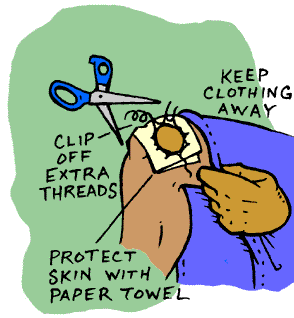Repair Pantyhose

Born to run!
Whether you’re dashing off to work or for a night out with your friends, all it takes is a bump against a table. Snag! Looking down at your leg, you see a hole in your new pair of pantyhose, and with every step you take it’ll start to run. Before you press the panic button, sit yourself down and fashion a patch for your hose. It’s a quick and easy job, and pantyhose repaired with nail polish is durable–your patch won’t wash off.
Note: These repairs work equally well for knee-high stockings, thigh-high stockings, or one-piece pantyhose, as long as they’re made of nylon.
![]()
Here’s the crux of pantyhose management: be on the watch for snags and small tears. As you may be aware, these minor accidents impair the integrity of the pantyhose fabric, creating long and unsightly runs that all but unravel a pair of pantyhose. While a long run going down your leg is beyond repair, you can limit the damage until a replacement is available.
How do this avoid this mess? Traditional Chinese wisdom recommends: “Fix a problem while it’s small–before it becomes a problem.” This translates as, repair holes as soon as possible, before they turn into runs. If you think you’ve snagged your pantyhose, check them thoroughly. If you do find a small hole or a small run, don’t bother taking them off and getting tangled up in a lot of material–you can repair them right on your leg. However, if the hole is quite large, you may want to take at least that leg off to avoid slopping polish all over your skin.
![]() Clear the area
Clear the area
- Remove the tendrils of nylon. You may find some threads of nylon that ripped when you tore the hole, and these will become more holes and runs if left unrepaired. Carefully–so as to not cut any more of the pantyhose–snip the thread away as close to the base as possible without getting too close to the rest of the material.

- Keep your clothing away. Make sure your clothes–pants, skirts, or anything else–are well away from the area of affliction . You don’t want to damage your clothes with nail polish.
- Protect your skin. Although nail polish will come off your skin, it’s still a good idea to avoid getting any on the skin near the hole. Put a piece of paper towel over your skin and under the pantyhose, on the area where you’ll apply the nail polish. Also, keep the damp cloth handy for wiping up spills.
![]() Repair holes
Repair holes
- Gathera small amount of polish. Don’t dip too much polish on the brush, or it’ll drip everywhere and get on unwanted areas. Get just enough to engulf the brush, but not so much that it’s about to drip off the brush.
- Lift away the nylon material. If your pantyhose are still on your leg, hold the material away from your skin with your thumb and forefinger. If you’ve taken them off, hold the damaged material away from the rest of the pantyhose. Don’t pull too hard on the material or you’ll cause the run to travel further. An inch (about 2 cm) or less is fine.

- Dab around the hole. Gently dab–don’t brush–the edges of the hole. Avoid applying excess polish onto the undamaged pantyhose, or else you’ll be able to see the excess as a big, dry whitish spot. Make sure you dab all edges of the hole, because runs will take off from the hole at the first opportunity.
- Clean up polish spills. If you accidentally apply polish too far beyond the hole, or get it on your skin, dab it with a damp cloth immediately.
- Allow for drying time. If you hurry out the door directly after applying the polish, the polish will get all over your skin and won’t have the time to harden around the hole and make a good patch. But don’t worry–nail polish only takes about three to five minutes to dry completely, and even less if it’s a small dabbing.
![]() Repair runs
Repair runs
Holes are different from runs–holes are easier to contain, and smaller. Runs can require extra attention, as they may have lots of damaged material to be sealed off.
- Dealing with run: Runs cannot be repaired as easily as holes can, but they can be stopped before they do further damage. Be sure to seal off both ends of the run–this will halt its growth.
- It’s also a good idea to put a little polish along the edges of the run–say, an inch or so (2-3 cm) from both of the ends. Again, this will prevent new runs from branching off the main run.

-end-
Januari 15, 2009 at 11:52 am
Makasih tipsnya.. bisa berhemat neh
🙂
Juli 12, 2009 at 2:45 am
mau kenal sama intan yg kasih comment di blog ini..
Februari 4, 2010 at 9:15 am
Intan,,pgn kenal ama kamu gmana yah caranya??